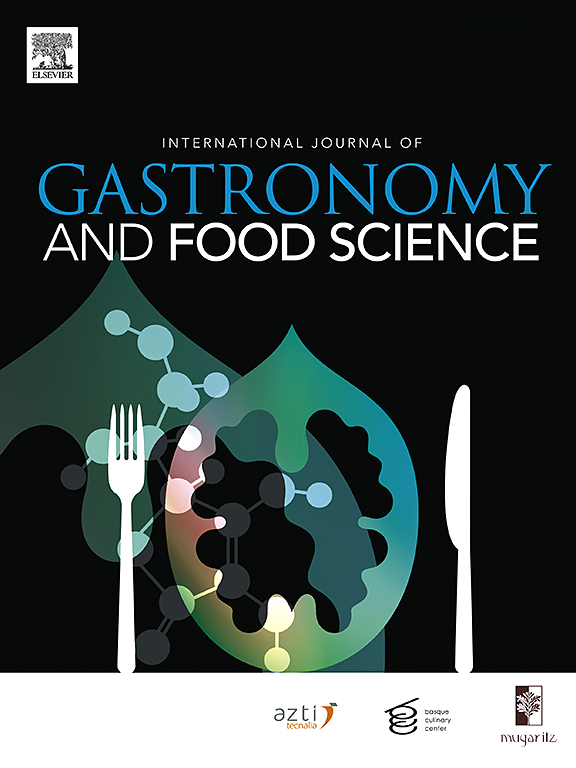加入脱水针尖草对针尖草冰淇淋微生物学、比色学和感官特性的影响
IF 3.2
2区 农林科学
Q2 FOOD SCIENCE & TECHNOLOGY
International Journal of Gastronomy and Food Science
Pub Date : 2025-01-03
DOI:10.1016/j.ijgfs.2025.101101
引用次数: 0
摘要
针叶树(malpiighia marginata DC)是一种热带水果,因其独特的风味和高水平的抗坏血酸和抗氧化化合物而备受重视。人们对更有营养、更健康、更有功能和更可持续的食品的兴趣日益增长,这推动了这一领域的研究。本研究的目的是在分析当地消费者的认知和评估添加脱水针叶对冰淇淋微生物学、比色学和感官特性的影响的基础上,开发一种含有针叶果肉和脱水针叶的乳制品冰淇淋甜点。这项研究包括用描述性定量方法进行实地调查,以及对生产的冰淇淋进行微生物学、比色学和感官分析。感官评价显示,针叶果味冰淇淋的接受度最高,得分为“一般喜欢”(7分)和“非常喜欢”(8分)。含有脱水针叶果味的冰淇淋得分为6分(“稍微喜欢”)和7分(“一般喜欢”)。虽然标准样品的感官接受度和亮度最好,但脱水针尖草配方也得到了肯定的评价。本文章由计算机程序翻译,如有差异,请以英文原文为准。
Impact of adding dehydrated acerola (Malpighia emarginata DC) on the microbiological, colorimetric, and sensory characteristics of acerola ice cream
Acerola (Malpighia emarginata DC) is a tropical fruit highly valued for its distinctive flavor and high levels of ascorbic acid and antioxidant compounds. The growing interest in more nutritious, healthy, functional, and sustainable foods has driven research in this area. The objective of this study was to develop a dairy-based ice cream dessert incorporating acerola pulp and dehydrated acerola, based on an analysis of local consumer perception and on evaluating the effects of adding dehydrated acerola on microbiological, colorimetric, and sensory ice cream characteristics. The study involved field research with a descriptive quantitative approach, as well as microbiological, colorimetric, and sensory analyses of the produced ice creams. The sensory evaluation revealed that the ice cream flavored with acerola pulp received the highest acceptance, with scores of “moderately liked” (7) and “liked very much” (8). Ice creams containing dehydrated acerola received scores of 6 (“slightly liked”) and 7 (“moderately liked”). Although the standard sample showed the best sensory acceptance and brightness, the formulations with dehydrated acerola were also positively evaluated.
求助全文
通过发布文献求助,成功后即可免费获取论文全文。
去求助
来源期刊

International Journal of Gastronomy and Food Science
Social Sciences-Cultural Studies
CiteScore
5.30
自引率
10.50%
发文量
170
审稿时长
45 days
期刊介绍:
International Journal of Gastronomy and Food Science is a peer-reviewed journal that explicitly focuses on the interface of food science and gastronomy. Articles focusing only on food science will not be considered. This journal equally encourages both scientists and chefs to publish original scientific papers, review articles and original culinary works. We seek articles with clear evidence of this interaction. From a scientific perspective, this publication aims to become the home for research from the whole community of food science and gastronomy.
IJGFS explores all aspects related to the growing field of the interaction of gastronomy and food science, in areas such as food chemistry, food technology and culinary techniques, food microbiology, genetics, sensory science, neuroscience, psychology, culinary concepts, culinary trends, and gastronomic experience (all the elements that contribute to the appreciation and enjoyment of the meal. Also relevant is research on science-based educational programs in gastronomy, anthropology, gastronomic history and food sociology. All these areas of knowledge are crucial to gastronomy, as they contribute to a better understanding of this broad term and its practical implications for science and society.
 求助内容:
求助内容: 应助结果提醒方式:
应助结果提醒方式:


